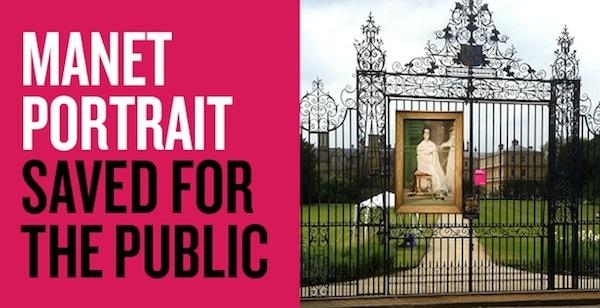The Ashmolean Museum has succeeded in raising £7.83 million to acquire Edouard Manet’s Portrait of Mademoiselle Claus and keep it in the United Kingdom. The painting was saved Following an 8 month campaign with donations from hundreds of members of the public. The painting was purchased by a foreign buyer in 2011 for £28.35 million. Following advice from the Reviewing Committee on the Export of Works of Art, the picture was judged to be of outstanding cultural importance and was placed under a temporary export bar until 7 August 2012 by Culture Minister Ed Vaizey. Under the terms of a private treaty sale, the painting was made available to a British public institution for 27% of its market value, and it was purchased through the London Fine Art agent, Robert Holden Ltd. It is the most significant acquisition in the Ashmolean’s history.
Dr Christopher Brown CBE, Director of the Ashmolean, said, “The public’s response to the campaign for the Manet has been overwhelming. The Museum is enormously grateful to the Heritage Lottery Fund, the Art Fund, other foundations and many individuals who contributed so generously and helped us save Manet for the public. To have succeeded in acquiring the portrait this year, when the UK is in the international spotlight, is something of which the Museum and the entire country can be proud. This is one of the most important pictures of the 19th century which has been in Britain since its sale following the artist’s death in 1884. Its acquisition has transformed the Ashmolean’s collection and has at a stroke made Oxford into a leading centre for the study of Impressionist painting.”
Culture Minister Ed Vaizey said, “I am delighted that the temporary export bar I placed on the painting has resulted in the Ashmolean being able to acquire this fantastic work by one of the greatest painters of the 19th Century. I congratulate the Ashmolean on their campaign and it’s wonderful that Manet’s painting will now be on public display where it can be enjoyed and appreciated by all.”
The campaign has received lead support of £5.9 million from the Heritage Lottery Fund (HLF), and a grant of £850,000 from The Art Fund. The final £1,080,000 was contributed via grants and donations from trusts, foundations and private individuals.
As well as to those who wish to remain anonymous, the Ashmolean Museum is extremely grateful to the Friends of the Ashmolean Museum; the Patrons of the Ashmolean Museum; the University of Oxford; Manny & Brigitta Davidson and family; Mr and Mrs Geoffrey de Jager; Sir Harry and Lady Djanogly; Mr Philip Mould; The Rothschild Foundation; The Dr Mortimer & Theresa Sackler Foundation; Mr and Mrs Timothy Sanderson; The Staples Trust ; Sir Adrian Swire; Mr and Mrs Bernard Taylor; Barrie and Deedee Wigmore; Mr and Mrs Brian Wilson; The JL Wine Charitable Trust and The Woodward Charitable Trust.
The Ashmolean also wishes to thank each of the 1,048 people who made a gift in response to our public appeal. The public appeal attracted gifts from across the globe, with donations ranging from £1.50 to £10,000.
Carole Souter, Chief Executive of the Heritage Lottery Fund, said, “The Ashmolean deserves a gold medal for reaching the finish line and securing Manet’s Mademoiselle Claus. Thanks to an imaginative fundraising campaign this elegant portrait will remain here in the UK in perpetuity. This is a proud moment for everyone involved but without a doubt the real credit goes to the Museum for its tenacity and vision.”
Stephen Deuchar, Director of the Art Fund, said, “Manet’s Mlle Claus is a beautiful, beguiling and exceptionally important painting: We’re delighted to have supported the Ashmolean Museum’s successful public appeal with a major Art Fund grant – indeed one of our largest ever.”
Manet was one of the greatest painters of the 19th century. During his lifetime he was controversial, but his work, though it shocked the public, was hugely admired by artists. His reputation grew rapidly in the 20th century and consequently his best works were acquired by major museums. There are now remarkably few Manets in private collections, almost all in France, and there are only a handful of important pictures by Manet in the United Kingdom – in the National Gallery and the Courtauld Institute in London, as well as other works in Cardiff, Birmingham, and Glasgow. Adding to the Museum’s permanent collections and the Pissarro Family Collection, the acquisition of this masterpiece makes the Ashmolean a world-leading centre for the study of Impressionist and Post-Impressionist work.
The portrait is a first version of Le Balcon (1868–9) now in the Musée d’Orsay – one of the key images of the Impressionist movement. Initially inspired by the sight of people on a balcony, during a summer spent in Boulogne-sur-Mer with his family in 1868, Le Balcon famously draws on Goya’s Majas on a Balcony painted around 1810. It is also an important example of Manet’s work from the late 1860s onwards when he began to focus his attention on his family and close friends. The portrait’s subject is Fanny Claus (1846–77), the closest friend of Manet’s wife Suzanne Leenhoff. A concert violinist and member of the first all-women string quartet, Fanny was a member of a close-knit group of friends who also provided the artist with models. She married the artist Pierre Prins (1838–1913), another friend of Manet’s, in 1869, but died of tuberculosis just eight years later at the age of 30.
Having been acquired by the Ashmolean, Portrait of Mademoiselle Claus will be lent to public museums and galleries in a nationwide tour in 2013.

